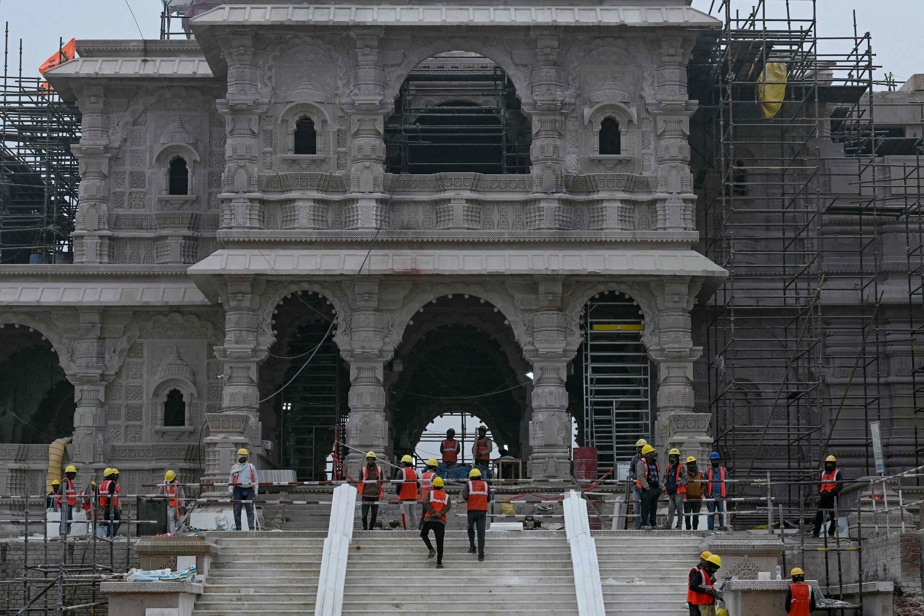(Ayodhya) Emblematic site of communal tensions in India, the city of Ayodhya, in the state of Uttar Pradesh, is putting the finishing touches to the construction of a controversial temple built on the site of an ancient mosque and which has become the symbol of Hindu nationalism.
Prime Minister Narendra Modi, who launched the project in August 2020, will come in January to inaugurate this new temple, dedicated to the god Ram, seventh avatar of the preserving god of the universe Vishnu.
It stands in this holy city of Hinduism, on the site of the Babri mosque, destroyed on December 6, 1992 by Hindu zealots claiming that this 1.1 hectare land is the birthplace of the god Ram.
Hindu groups have long called for a temple to be built on the site to honor Ram. According to them, the Muslim emperor Babur had built there in the 16the century the mosque by razing an ancient temple dedicated to Ram.
Muslim residents of Ayodhya are worried, remembering the bloody interfaith riots which accompanied the demolition of the mosque, leaving more than 2,000 dead.
Others see it as a way to restore the glory of the city described in ancient Hindu texts and to prove Mr. Modi’s commitment to defending the majority religion in the country, a few months before national elections.
“Modi kept his promise,” Gudiya Devi, a housewife met in front of another temple in Ayodhya after her morning prayers, told AFP.
“We have been dreaming of an imposing Ram temple all these years and now our dream is coming true,” she adds. “All thanks to Modi. He’s really our leader.”
“Delighted”
From the top of their bamboo ladders, artisans complete the decoration of the main structure of the imposing temple which is fifty meters high at its highest point.
It cost about 20 billion rupees ($318 million), according to project manager Jagdish Aphale, and its builders hope that tens of millions of Hindu pilgrims will visit it each year.
Government money was poured into Ayodhya to make it look good before the inauguration. A new international airport will open on Saturday, rail and road links have been improved and a number of new hotels have suddenly sprung up.
Aisles and pillars were decorated with saffron flags and garlands of flowers to welcome travelers.
“There are so many pilgrims who have started coming,” observes Shubh Mangal, 52, a seller of flowers and other offerings popular with Hindu faithful. “I doubled my profit. We are all delighted.”
Ram is one of the most revered gods in the Hindu pantheon for whom he was born in Ayodhya some 7,000 years ago, on the site where the mosque was later built.
“Filled with fear”
Mr. Modi’s presence at the inauguration of the temple will mark the effective start of his campaign for his re-election in 2024.
His Hindu nationalist party, the Bharatiya Janata Party (BJP), campaigned for decades for the construction of a temple in place of the mosque and its activists were at the heart of the demolition of the Muslim place of worship.
A senior BJP official was touring the country to mobilize the faithful in a Toyota fitted out to resemble the legendary Ram chariot and triggering religious riots in his path.
The destruction of the mosque had dealt a heavy blow to the secular and multi-faith nation that had planned for independence in 1947, paving the way for the rise of Hindu nationalism.
A sea serpent of Indian politics for decades, the case was decided in 2019 by the Supreme Court, granting the disputed site to the Hindu majority and ordering the granting of new land further away to the Muslim minority.
On the Muslim side, Haji Mehboob believes that Mr. Modi’s presence at the inauguration will mark a new stage in the growing influence of Hinduism in political life.
“The prime minister of a secular country comes to inaugurate a Hindu temple […] with an eye on a victory in the 2024 elections by winning over its Hindu base,” he confided to AFP. “The Muslims of Ayodhya are filled with dread about what the future holds for them.”
